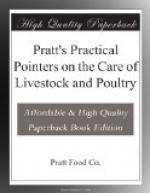Here are a few basic facts:
Sheep raising requires careful attention, but does not demand a great amount of heavy labor or expensive equipment.
The best time to make a start is in the early fall when good breeding stock may be selected.
While pure-bred breeders are best, a pure-bred ram and ewes of good grade will prove very satisfactory.
A start may be made in a small way, but it is best to have at least twenty to forty breeders for economy of time, labor and other expenses.
As a rule it is most profitable to push the lambs for growth and market them when they weigh 65 to 75 pounds.
This weight can be secured in about four months.
If a very large pasture is available the flock will
thrive on this.
Otherwise fields must be fenced off and forage crops
provided.
Breeding ewes must be exercised in the winter to insure strong lambs. But protect them from rain or wet snow as soaked fleeces cause colds and pneumonia.
[Illustration: SHROPSHIRE SHEEP]
Thrifty condition and vigorous health must be maintained at all costs. Otherwise the lambs will be small and weak and fleeces of inferior quality. The regular use of Pratts Animal Regulator will improve condition, insure health and vigor, increase number and quality of lambs, promote growth of flesh and wool. And in large measure, it keeps common diseases away because Pratt-fed sheep are in condition to resist disease.
Shearing should be done after lambing, usually in late spring or early summer. If lambing time is late, the shearing may be done before the lambs arrive. Tie up the fleeces separately, first sorting out dung locks and tags.
After lambing, the individual ewes should be carefully watched to see that they have plenty of milk and are in good condition. They should be kept in pens for about three days, when they may be permitted to run with the flock. Feed lightly for two or three days, then heavily to stimulate the milk flow so lambs will be well-nourished. They may profitably receive one to two pounds of grain per day during the nursing period.
Inferior ewes should be marketed as rapidly as they are identified. Get rid of the barren ones, producers of poor lambs, poor milkers, light shearers.
Sheep must be protected against blood-thirsty dogs and external and internal parasites. In many sections sheep growers have united to fight sheep-killing dogs and good results have been secured. United action against a common enemy is best, as public sentiment may thus be aroused.
Because of their thick fleeces and helplessness, sheep suffer greatly from the attacks of ticks, lice and other parasites. Ticks are particularly injurious. They annoy and weaken the adult animals, torture the lambs and check their growth. The result is always a money loss to the sheep owner.
Fortunately it is a simple matter to exterminate the ticks and lice and overcome the ordinary skin diseases of sheep. Merely dip the sheep in a solution of Pratts Disinfectant. It is non-poisonous, inexpensive—does the work!




